A Critical Analysis of Health Definition and Epidemiological Studies
VerifiedAdded on 2023/01/13
|9
|2463
|59
Report
AI Summary
This report delves into the multifaceted concept of health, beginning with the WHO's definition of health as a state of complete physical, mental, and social well-being, and not merely the absence of disease. It then explores the significance of epidemiology in understanding disease patterns and health determinants. The report presents a comparative analysis of factors influencing both physical and mental health, including environmental factors, genetics, and education levels. It also examines the role of epidemiology in identifying disease causes, monitoring outbreaks, and collecting data on health risk factors. Furthermore, the report discusses the interactions between various health aspects and their impact on overall population health. The paper also critiques the WHO's definition in light of the current rise in chronic diseases, arguing for the continued relevance of the definition while recognizing the need for a broader understanding of health determinants. The report concludes by emphasizing the importance of epidemiological studies in predicting and controlling the spread of communicable diseases and addressing health disparities.

Health, Its Meaning and Epidemiology1
HEALTH, ITS MEANING AND EPIDEMIOLOGY
by [Name]
Course:
Tutor:
Institution
City
Date
HEALTH, ITS MEANING AND EPIDEMIOLOGY
by [Name]
Course:
Tutor:
Institution
City
Date
Paraphrase This Document
Need a fresh take? Get an instant paraphrase of this document with our AI Paraphraser
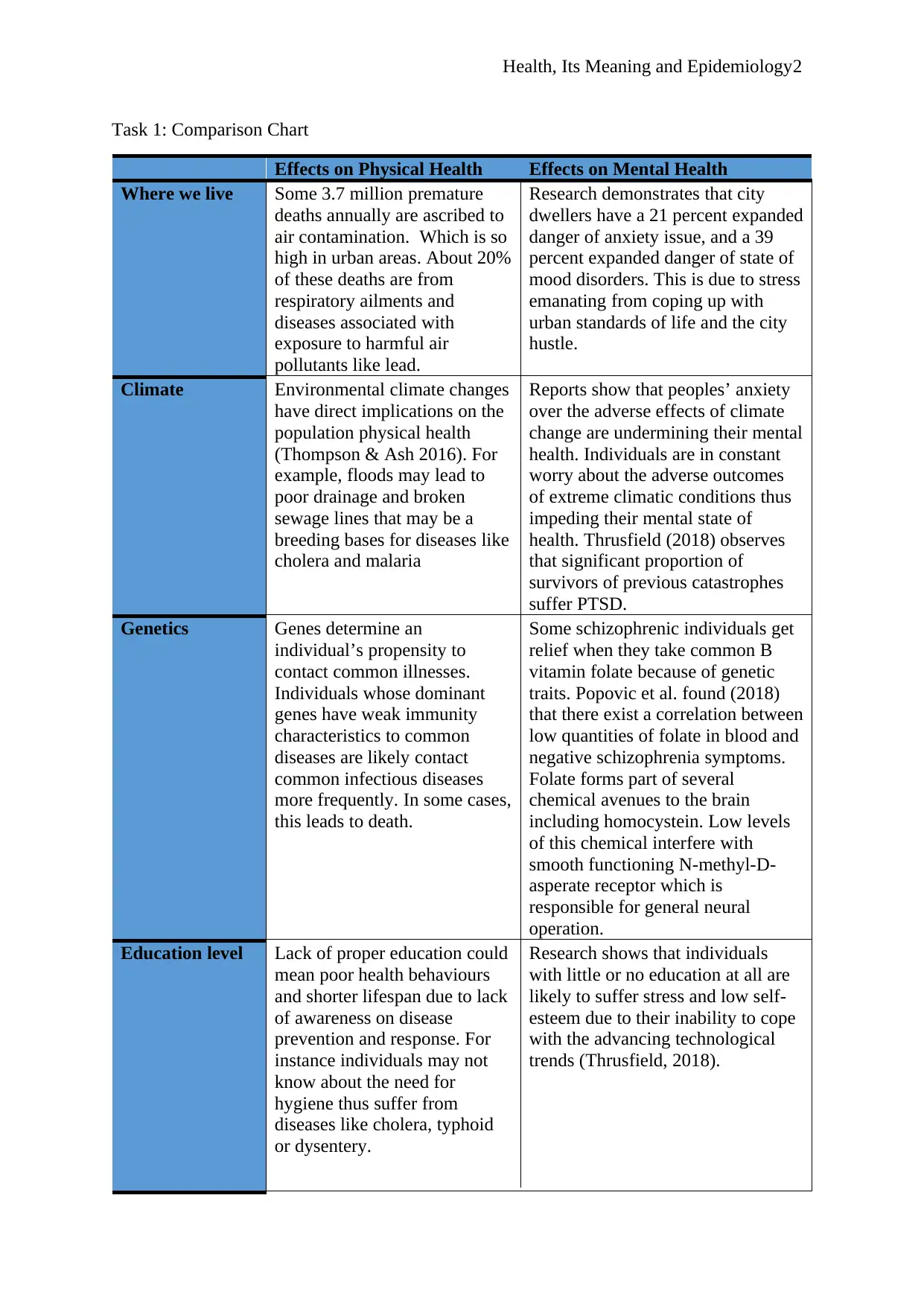
Health, Its Meaning and Epidemiology2
Task 1: Comparison Chart
Effects on Physical Health Effects on Mental Health
Where we live Some 3.7 million premature
deaths annually are ascribed to
air contamination. Which is so
high in urban areas. About 20%
of these deaths are from
respiratory ailments and
diseases associated with
exposure to harmful air
pollutants like lead.
Research demonstrates that city
dwellers have a 21 percent expanded
danger of anxiety issue, and a 39
percent expanded danger of state of
mood disorders. This is due to stress
emanating from coping up with
urban standards of life and the city
hustle.
Climate Environmental climate changes
have direct implications on the
population physical health
(Thompson & Ash 2016). For
example, floods may lead to
poor drainage and broken
sewage lines that may be a
breeding bases for diseases like
cholera and malaria
Reports show that peoples’ anxiety
over the adverse effects of climate
change are undermining their mental
health. Individuals are in constant
worry about the adverse outcomes
of extreme climatic conditions thus
impeding their mental state of
health. Thrusfield (2018) observes
that significant proportion of
survivors of previous catastrophes
suffer PTSD.
Genetics Genes determine an
individual’s propensity to
contact common illnesses.
Individuals whose dominant
genes have weak immunity
characteristics to common
diseases are likely contact
common infectious diseases
more frequently. In some cases,
this leads to death.
Some schizophrenic individuals get
relief when they take common B
vitamin folate because of genetic
traits. Popovic et al. found (2018)
that there exist a correlation between
low quantities of folate in blood and
negative schizophrenia symptoms.
Folate forms part of several
chemical avenues to the brain
including homocystein. Low levels
of this chemical interfere with
smooth functioning N-methyl-D-
asperate receptor which is
responsible for general neural
operation.
Education level Lack of proper education could
mean poor health behaviours
and shorter lifespan due to lack
of awareness on disease
prevention and response. For
instance individuals may not
know about the need for
hygiene thus suffer from
diseases like cholera, typhoid
or dysentery.
Research shows that individuals
with little or no education at all are
likely to suffer stress and low self-
esteem due to their inability to cope
with the advancing technological
trends (Thrusfield, 2018).
Task 1: Comparison Chart
Effects on Physical Health Effects on Mental Health
Where we live Some 3.7 million premature
deaths annually are ascribed to
air contamination. Which is so
high in urban areas. About 20%
of these deaths are from
respiratory ailments and
diseases associated with
exposure to harmful air
pollutants like lead.
Research demonstrates that city
dwellers have a 21 percent expanded
danger of anxiety issue, and a 39
percent expanded danger of state of
mood disorders. This is due to stress
emanating from coping up with
urban standards of life and the city
hustle.
Climate Environmental climate changes
have direct implications on the
population physical health
(Thompson & Ash 2016). For
example, floods may lead to
poor drainage and broken
sewage lines that may be a
breeding bases for diseases like
cholera and malaria
Reports show that peoples’ anxiety
over the adverse effects of climate
change are undermining their mental
health. Individuals are in constant
worry about the adverse outcomes
of extreme climatic conditions thus
impeding their mental state of
health. Thrusfield (2018) observes
that significant proportion of
survivors of previous catastrophes
suffer PTSD.
Genetics Genes determine an
individual’s propensity to
contact common illnesses.
Individuals whose dominant
genes have weak immunity
characteristics to common
diseases are likely contact
common infectious diseases
more frequently. In some cases,
this leads to death.
Some schizophrenic individuals get
relief when they take common B
vitamin folate because of genetic
traits. Popovic et al. found (2018)
that there exist a correlation between
low quantities of folate in blood and
negative schizophrenia symptoms.
Folate forms part of several
chemical avenues to the brain
including homocystein. Low levels
of this chemical interfere with
smooth functioning N-methyl-D-
asperate receptor which is
responsible for general neural
operation.
Education level Lack of proper education could
mean poor health behaviours
and shorter lifespan due to lack
of awareness on disease
prevention and response. For
instance individuals may not
know about the need for
hygiene thus suffer from
diseases like cholera, typhoid
or dysentery.
Research shows that individuals
with little or no education at all are
likely to suffer stress and low self-
esteem due to their inability to cope
with the advancing technological
trends (Thrusfield, 2018).
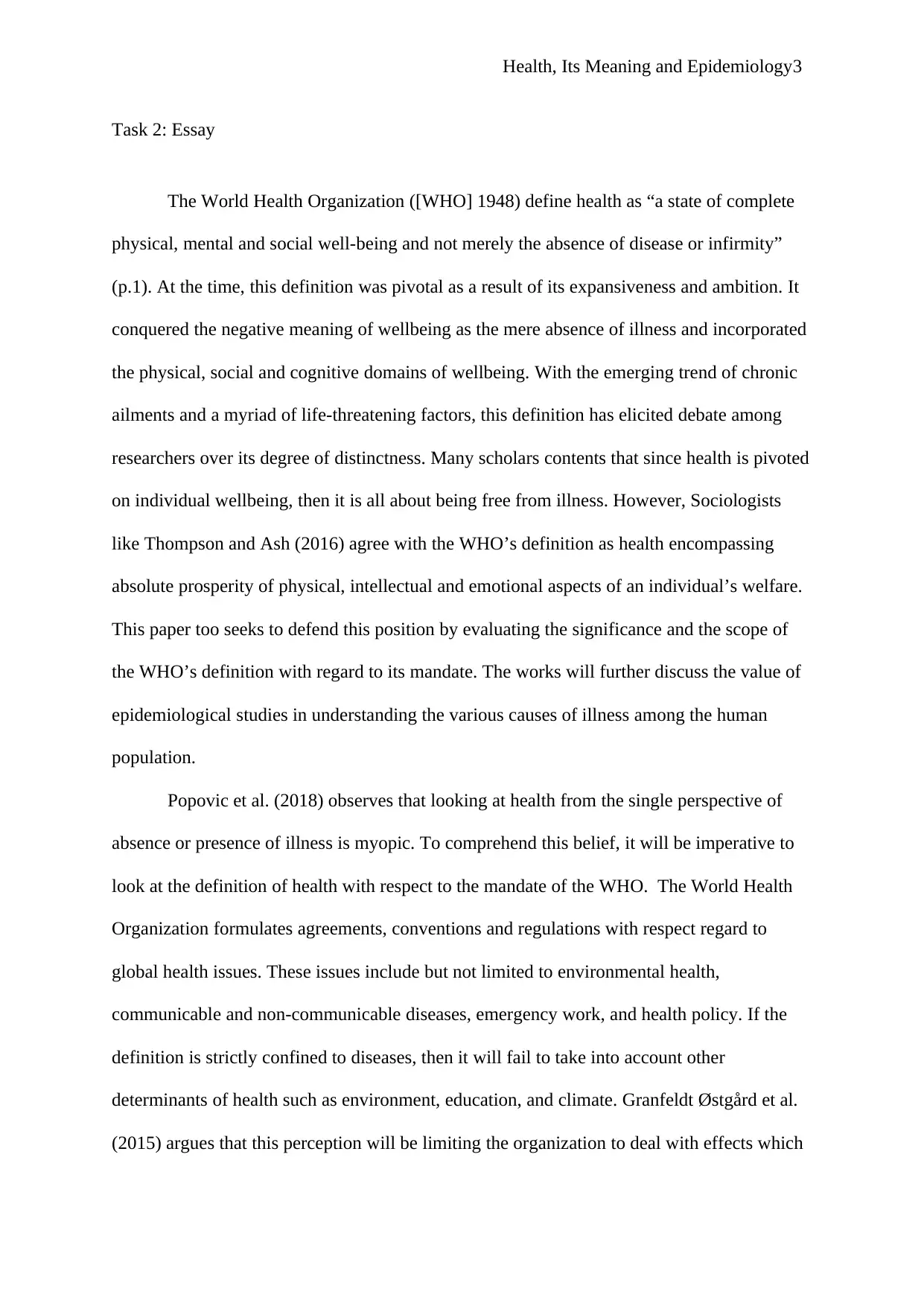
Health, Its Meaning and Epidemiology3
Task 2: Essay
The World Health Organization ([WHO] 1948) define health as “a state of complete
physical, mental and social well-being and not merely the absence of disease or infirmity”
(p.1). At the time, this definition was pivotal as a result of its expansiveness and ambition. It
conquered the negative meaning of wellbeing as the mere absence of illness and incorporated
the physical, social and cognitive domains of wellbeing. With the emerging trend of chronic
ailments and a myriad of life-threatening factors, this definition has elicited debate among
researchers over its degree of distinctness. Many scholars contents that since health is pivoted
on individual wellbeing, then it is all about being free from illness. However, Sociologists
like Thompson and Ash (2016) agree with the WHO’s definition as health encompassing
absolute prosperity of physical, intellectual and emotional aspects of an individual’s welfare.
This paper too seeks to defend this position by evaluating the significance and the scope of
the WHO’s definition with regard to its mandate. The works will further discuss the value of
epidemiological studies in understanding the various causes of illness among the human
population.
Popovic et al. (2018) observes that looking at health from the single perspective of
absence or presence of illness is myopic. To comprehend this belief, it will be imperative to
look at the definition of health with respect to the mandate of the WHO. The World Health
Organization formulates agreements, conventions and regulations with respect regard to
global health issues. These issues include but not limited to environmental health,
communicable and non-communicable diseases, emergency work, and health policy. If the
definition is strictly confined to diseases, then it will fail to take into account other
determinants of health such as environment, education, and climate. Granfeldt Østgård et al.
(2015) argues that this perception will be limiting the organization to deal with effects which
Task 2: Essay
The World Health Organization ([WHO] 1948) define health as “a state of complete
physical, mental and social well-being and not merely the absence of disease or infirmity”
(p.1). At the time, this definition was pivotal as a result of its expansiveness and ambition. It
conquered the negative meaning of wellbeing as the mere absence of illness and incorporated
the physical, social and cognitive domains of wellbeing. With the emerging trend of chronic
ailments and a myriad of life-threatening factors, this definition has elicited debate among
researchers over its degree of distinctness. Many scholars contents that since health is pivoted
on individual wellbeing, then it is all about being free from illness. However, Sociologists
like Thompson and Ash (2016) agree with the WHO’s definition as health encompassing
absolute prosperity of physical, intellectual and emotional aspects of an individual’s welfare.
This paper too seeks to defend this position by evaluating the significance and the scope of
the WHO’s definition with regard to its mandate. The works will further discuss the value of
epidemiological studies in understanding the various causes of illness among the human
population.
Popovic et al. (2018) observes that looking at health from the single perspective of
absence or presence of illness is myopic. To comprehend this belief, it will be imperative to
look at the definition of health with respect to the mandate of the WHO. The World Health
Organization formulates agreements, conventions and regulations with respect regard to
global health issues. These issues include but not limited to environmental health,
communicable and non-communicable diseases, emergency work, and health policy. If the
definition is strictly confined to diseases, then it will fail to take into account other
determinants of health such as environment, education, and climate. Granfeldt Østgård et al.
(2015) argues that this perception will be limiting the organization to deal with effects which
⊘ This is a preview!⊘
Do you want full access?
Subscribe today to unlock all pages.

Trusted by 1+ million students worldwide
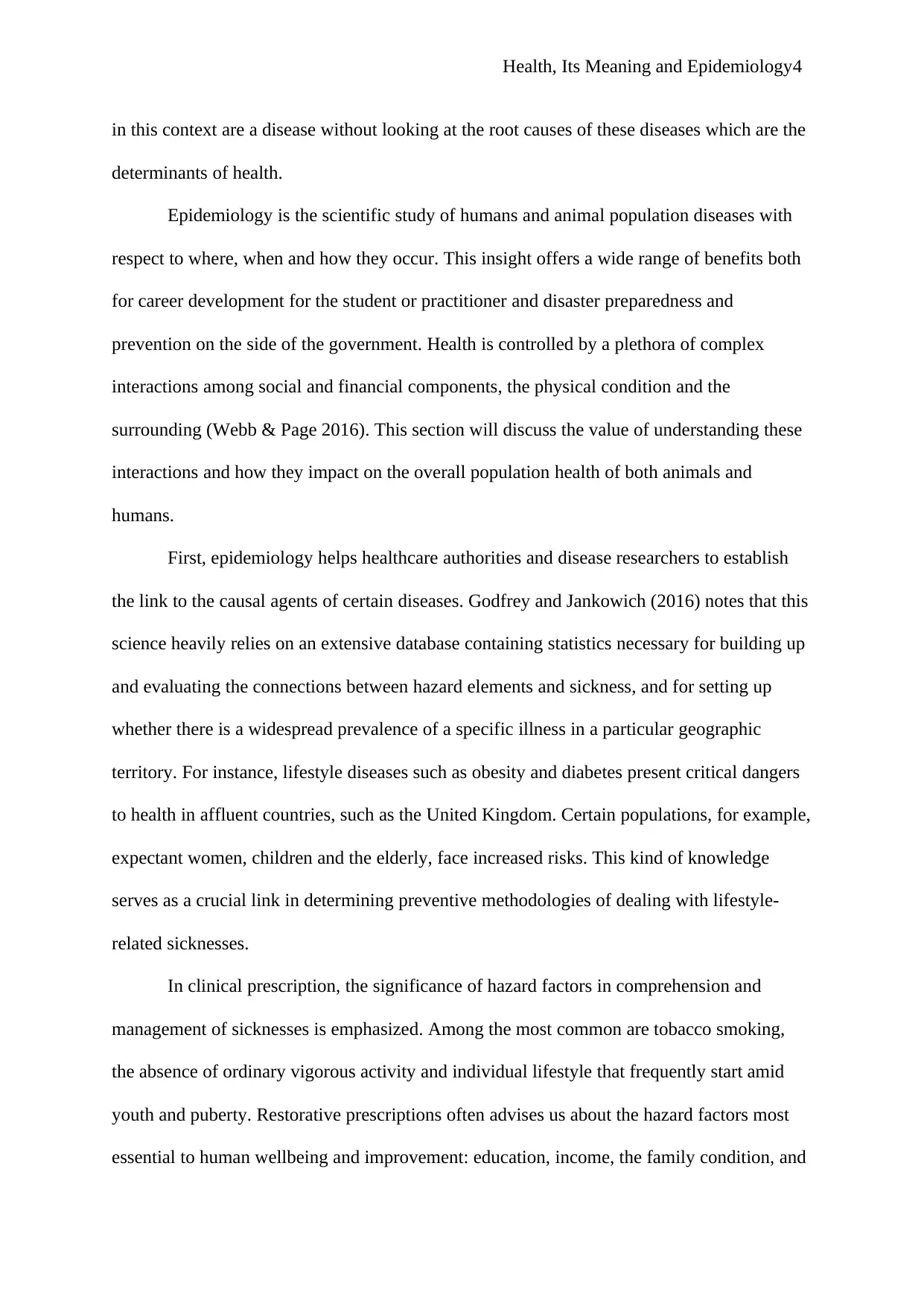
Health, Its Meaning and Epidemiology4
in this context are a disease without looking at the root causes of these diseases which are the
determinants of health.
Epidemiology is the scientific study of humans and animal population diseases with
respect to where, when and how they occur. This insight offers a wide range of benefits both
for career development for the student or practitioner and disaster preparedness and
prevention on the side of the government. Health is controlled by a plethora of complex
interactions among social and financial components, the physical condition and the
surrounding (Webb & Page 2016). This section will discuss the value of understanding these
interactions and how they impact on the overall population health of both animals and
humans.
First, epidemiology helps healthcare authorities and disease researchers to establish
the link to the causal agents of certain diseases. Godfrey and Jankowich (2016) notes that this
science heavily relies on an extensive database containing statistics necessary for building up
and evaluating the connections between hazard elements and sickness, and for setting up
whether there is a widespread prevalence of a specific illness in a particular geographic
territory. For instance, lifestyle diseases such as obesity and diabetes present critical dangers
to health in affluent countries, such as the United Kingdom. Certain populations, for example,
expectant women, children and the elderly, face increased risks. This kind of knowledge
serves as a crucial link in determining preventive methodologies of dealing with lifestyle-
related sicknesses.
In clinical prescription, the significance of hazard factors in comprehension and
management of sicknesses is emphasized. Among the most common are tobacco smoking,
the absence of ordinary vigorous activity and individual lifestyle that frequently start amid
youth and puberty. Restorative prescriptions often advises us about the hazard factors most
essential to human wellbeing and improvement: education, income, the family condition, and
in this context are a disease without looking at the root causes of these diseases which are the
determinants of health.
Epidemiology is the scientific study of humans and animal population diseases with
respect to where, when and how they occur. This insight offers a wide range of benefits both
for career development for the student or practitioner and disaster preparedness and
prevention on the side of the government. Health is controlled by a plethora of complex
interactions among social and financial components, the physical condition and the
surrounding (Webb & Page 2016). This section will discuss the value of understanding these
interactions and how they impact on the overall population health of both animals and
humans.
First, epidemiology helps healthcare authorities and disease researchers to establish
the link to the causal agents of certain diseases. Godfrey and Jankowich (2016) notes that this
science heavily relies on an extensive database containing statistics necessary for building up
and evaluating the connections between hazard elements and sickness, and for setting up
whether there is a widespread prevalence of a specific illness in a particular geographic
territory. For instance, lifestyle diseases such as obesity and diabetes present critical dangers
to health in affluent countries, such as the United Kingdom. Certain populations, for example,
expectant women, children and the elderly, face increased risks. This kind of knowledge
serves as a crucial link in determining preventive methodologies of dealing with lifestyle-
related sicknesses.
In clinical prescription, the significance of hazard factors in comprehension and
management of sicknesses is emphasized. Among the most common are tobacco smoking,
the absence of ordinary vigorous activity and individual lifestyle that frequently start amid
youth and puberty. Restorative prescriptions often advises us about the hazard factors most
essential to human wellbeing and improvement: education, income, the family condition, and
Paraphrase This Document
Need a fresh take? Get an instant paraphrase of this document with our AI Paraphraser
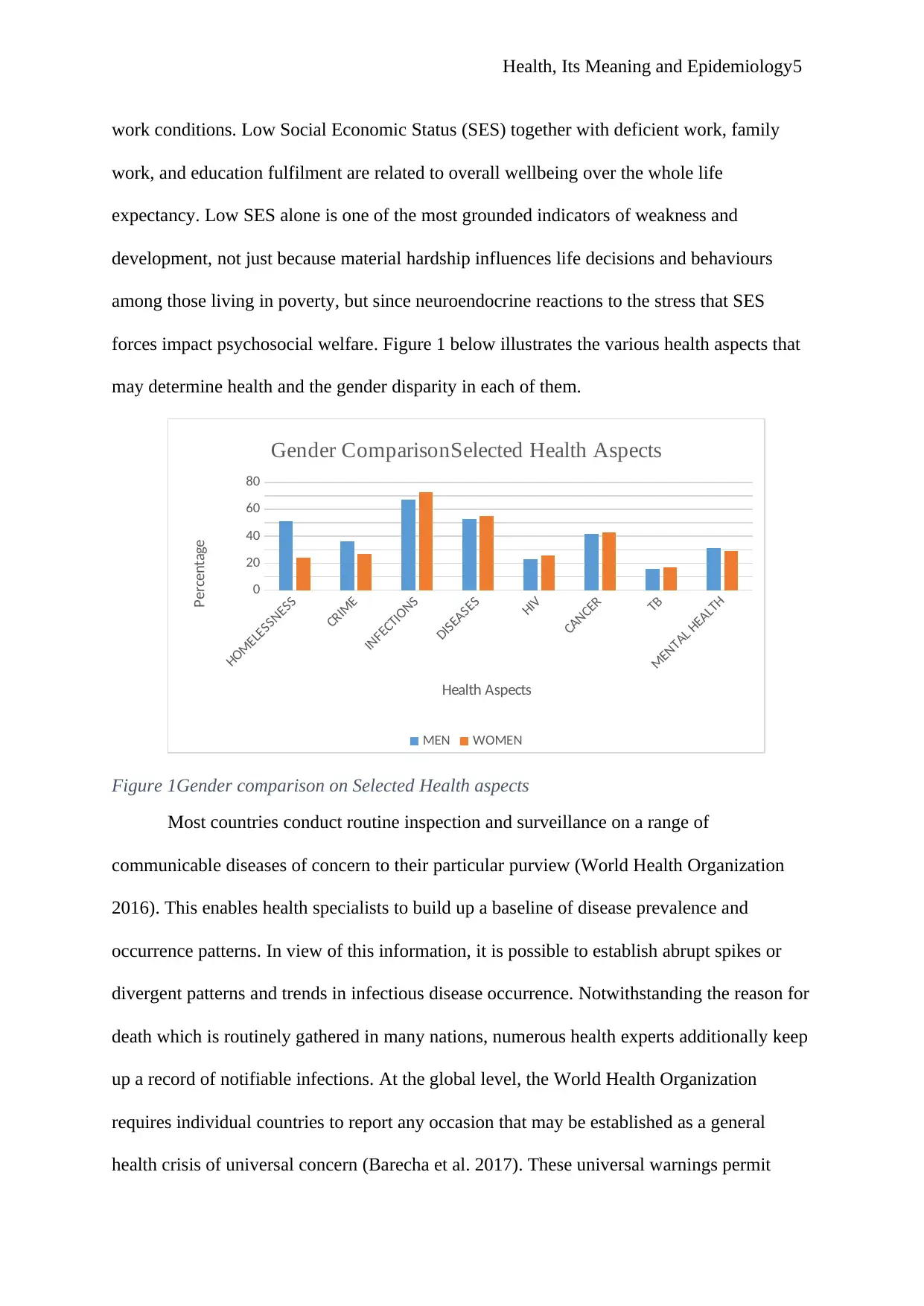
Health, Its Meaning and Epidemiology5
work conditions. Low Social Economic Status (SES) together with deficient work, family
work, and education fulfilment are related to overall wellbeing over the whole life
expectancy. Low SES alone is one of the most grounded indicators of weakness and
development, not just because material hardship influences life decisions and behaviours
among those living in poverty, but since neuroendocrine reactions to the stress that SES
forces impact psychosocial welfare. Figure 1 below illustrates the various health aspects that
may determine health and the gender disparity in each of them.
HOMELESSNESS
CRIME
INFECTIONS
DISEASES
HIV
CANCER
TB
MENTAL HEALTH
0
20
40
60
80
Gender ComparisonSelected Health Aspects
MEN WOMEN
Health Aspects
Percentage
Figure 1Gender comparison on Selected Health aspects
Most countries conduct routine inspection and surveillance on a range of
communicable diseases of concern to their particular purview (World Health Organization
2016). This enables health specialists to build up a baseline of disease prevalence and
occurrence patterns. In view of this information, it is possible to establish abrupt spikes or
divergent patterns and trends in infectious disease occurrence. Notwithstanding the reason for
death which is routinely gathered in many nations, numerous health experts additionally keep
up a record of notifiable infections. At the global level, the World Health Organization
requires individual countries to report any occasion that may be established as a general
health crisis of universal concern (Barecha et al. 2017). These universal warnings permit
work conditions. Low Social Economic Status (SES) together with deficient work, family
work, and education fulfilment are related to overall wellbeing over the whole life
expectancy. Low SES alone is one of the most grounded indicators of weakness and
development, not just because material hardship influences life decisions and behaviours
among those living in poverty, but since neuroendocrine reactions to the stress that SES
forces impact psychosocial welfare. Figure 1 below illustrates the various health aspects that
may determine health and the gender disparity in each of them.
HOMELESSNESS
CRIME
INFECTIONS
DISEASES
HIV
CANCER
TB
MENTAL HEALTH
0
20
40
60
80
Gender ComparisonSelected Health Aspects
MEN WOMEN
Health Aspects
Percentage
Figure 1Gender comparison on Selected Health aspects
Most countries conduct routine inspection and surveillance on a range of
communicable diseases of concern to their particular purview (World Health Organization
2016). This enables health specialists to build up a baseline of disease prevalence and
occurrence patterns. In view of this information, it is possible to establish abrupt spikes or
divergent patterns and trends in infectious disease occurrence. Notwithstanding the reason for
death which is routinely gathered in many nations, numerous health experts additionally keep
up a record of notifiable infections. At the global level, the World Health Organization
requires individual countries to report any occasion that may be established as a general
health crisis of universal concern (Barecha et al. 2017). These universal warnings permit
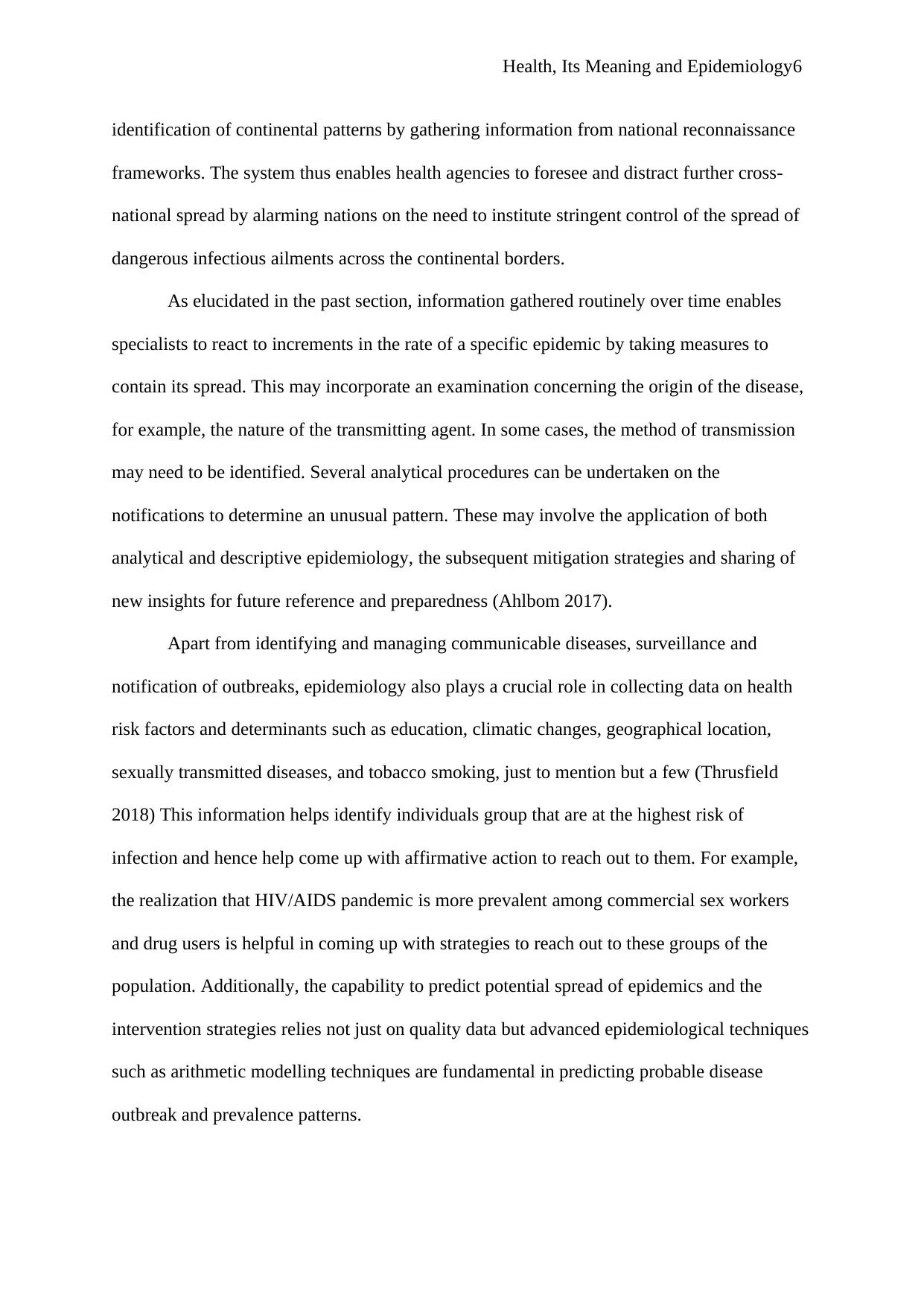
Health, Its Meaning and Epidemiology6
identification of continental patterns by gathering information from national reconnaissance
frameworks. The system thus enables health agencies to foresee and distract further cross-
national spread by alarming nations on the need to institute stringent control of the spread of
dangerous infectious ailments across the continental borders.
As elucidated in the past section, information gathered routinely over time enables
specialists to react to increments in the rate of a specific epidemic by taking measures to
contain its spread. This may incorporate an examination concerning the origin of the disease,
for example, the nature of the transmitting agent. In some cases, the method of transmission
may need to be identified. Several analytical procedures can be undertaken on the
notifications to determine an unusual pattern. These may involve the application of both
analytical and descriptive epidemiology, the subsequent mitigation strategies and sharing of
new insights for future reference and preparedness (Ahlbom 2017).
Apart from identifying and managing communicable diseases, surveillance and
notification of outbreaks, epidemiology also plays a crucial role in collecting data on health
risk factors and determinants such as education, climatic changes, geographical location,
sexually transmitted diseases, and tobacco smoking, just to mention but a few (Thrusfield
2018) This information helps identify individuals group that are at the highest risk of
infection and hence help come up with affirmative action to reach out to them. For example,
the realization that HIV/AIDS pandemic is more prevalent among commercial sex workers
and drug users is helpful in coming up with strategies to reach out to these groups of the
population. Additionally, the capability to predict potential spread of epidemics and the
intervention strategies relies not just on quality data but advanced epidemiological techniques
such as arithmetic modelling techniques are fundamental in predicting probable disease
outbreak and prevalence patterns.
identification of continental patterns by gathering information from national reconnaissance
frameworks. The system thus enables health agencies to foresee and distract further cross-
national spread by alarming nations on the need to institute stringent control of the spread of
dangerous infectious ailments across the continental borders.
As elucidated in the past section, information gathered routinely over time enables
specialists to react to increments in the rate of a specific epidemic by taking measures to
contain its spread. This may incorporate an examination concerning the origin of the disease,
for example, the nature of the transmitting agent. In some cases, the method of transmission
may need to be identified. Several analytical procedures can be undertaken on the
notifications to determine an unusual pattern. These may involve the application of both
analytical and descriptive epidemiology, the subsequent mitigation strategies and sharing of
new insights for future reference and preparedness (Ahlbom 2017).
Apart from identifying and managing communicable diseases, surveillance and
notification of outbreaks, epidemiology also plays a crucial role in collecting data on health
risk factors and determinants such as education, climatic changes, geographical location,
sexually transmitted diseases, and tobacco smoking, just to mention but a few (Thrusfield
2018) This information helps identify individuals group that are at the highest risk of
infection and hence help come up with affirmative action to reach out to them. For example,
the realization that HIV/AIDS pandemic is more prevalent among commercial sex workers
and drug users is helpful in coming up with strategies to reach out to these groups of the
population. Additionally, the capability to predict potential spread of epidemics and the
intervention strategies relies not just on quality data but advanced epidemiological techniques
such as arithmetic modelling techniques are fundamental in predicting probable disease
outbreak and prevalence patterns.
⊘ This is a preview!⊘
Do you want full access?
Subscribe today to unlock all pages.

Trusted by 1+ million students worldwide

Health, Its Meaning and Epidemiology7
This paper contents that the term health does not simply imply absence of diseases but
rather a harmonious combination of various physical, emotional and cognitive factors that
make up a complete individual. This definition magnifies the spectrum of the World Health
Organization to not only focus on prevention of population diseases but disease causing
factors as well. One way of going about this broad mandate is through Epidemiological
Studies, which can be viewed as a continuous and lifelong process of diseases monitoring and
surveillance. It is a powerful tool that enables healthcare systems to predict, identify and,
control spread of communicable diseases. With the rise of immunizable diseases in the UK
and other developed countries, epidemiologic monitoring of disease incidence patterns
remains critically paramount.
This paper contents that the term health does not simply imply absence of diseases but
rather a harmonious combination of various physical, emotional and cognitive factors that
make up a complete individual. This definition magnifies the spectrum of the World Health
Organization to not only focus on prevention of population diseases but disease causing
factors as well. One way of going about this broad mandate is through Epidemiological
Studies, which can be viewed as a continuous and lifelong process of diseases monitoring and
surveillance. It is a powerful tool that enables healthcare systems to predict, identify and,
control spread of communicable diseases. With the rise of immunizable diseases in the UK
and other developed countries, epidemiologic monitoring of disease incidence patterns
remains critically paramount.
Paraphrase This Document
Need a fresh take? Get an instant paraphrase of this document with our AI Paraphraser
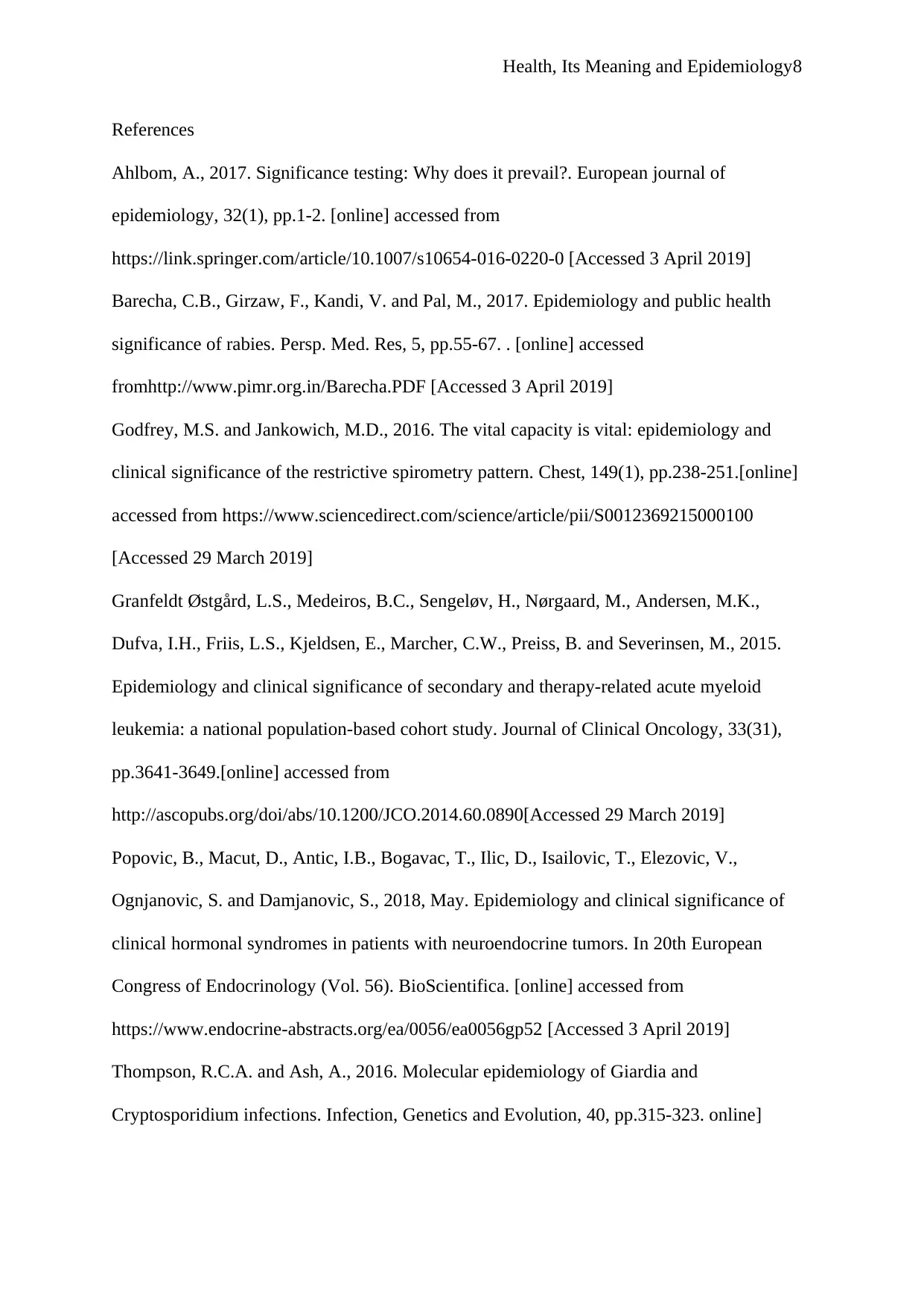
Health, Its Meaning and Epidemiology8
References
Ahlbom, A., 2017. Significance testing: Why does it prevail?. European journal of
epidemiology, 32(1), pp.1-2. [online] accessed from
https://link.springer.com/article/10.1007/s10654-016-0220-0 [Accessed 3 April 2019]
Barecha, C.B., Girzaw, F., Kandi, V. and Pal, M., 2017. Epidemiology and public health
significance of rabies. Persp. Med. Res, 5, pp.55-67. . [online] accessed
fromhttp://www.pimr.org.in/Barecha.PDF [Accessed 3 April 2019]
Godfrey, M.S. and Jankowich, M.D., 2016. The vital capacity is vital: epidemiology and
clinical significance of the restrictive spirometry pattern. Chest, 149(1), pp.238-251.[online]
accessed from https://www.sciencedirect.com/science/article/pii/S0012369215000100
[Accessed 29 March 2019]
Granfeldt Østgård, L.S., Medeiros, B.C., Sengeløv, H., Nørgaard, M., Andersen, M.K.,
Dufva, I.H., Friis, L.S., Kjeldsen, E., Marcher, C.W., Preiss, B. and Severinsen, M., 2015.
Epidemiology and clinical significance of secondary and therapy-related acute myeloid
leukemia: a national population-based cohort study. Journal of Clinical Oncology, 33(31),
pp.3641-3649.[online] accessed from
http://ascopubs.org/doi/abs/10.1200/JCO.2014.60.0890[Accessed 29 March 2019]
Popovic, B., Macut, D., Antic, I.B., Bogavac, T., Ilic, D., Isailovic, T., Elezovic, V.,
Ognjanovic, S. and Damjanovic, S., 2018, May. Epidemiology and clinical significance of
clinical hormonal syndromes in patients with neuroendocrine tumors. In 20th European
Congress of Endocrinology (Vol. 56). BioScientifica. [online] accessed from
https://www.endocrine-abstracts.org/ea/0056/ea0056gp52 [Accessed 3 April 2019]
Thompson, R.C.A. and Ash, A., 2016. Molecular epidemiology of Giardia and
Cryptosporidium infections. Infection, Genetics and Evolution, 40, pp.315-323. online]
References
Ahlbom, A., 2017. Significance testing: Why does it prevail?. European journal of
epidemiology, 32(1), pp.1-2. [online] accessed from
https://link.springer.com/article/10.1007/s10654-016-0220-0 [Accessed 3 April 2019]
Barecha, C.B., Girzaw, F., Kandi, V. and Pal, M., 2017. Epidemiology and public health
significance of rabies. Persp. Med. Res, 5, pp.55-67. . [online] accessed
fromhttp://www.pimr.org.in/Barecha.PDF [Accessed 3 April 2019]
Godfrey, M.S. and Jankowich, M.D., 2016. The vital capacity is vital: epidemiology and
clinical significance of the restrictive spirometry pattern. Chest, 149(1), pp.238-251.[online]
accessed from https://www.sciencedirect.com/science/article/pii/S0012369215000100
[Accessed 29 March 2019]
Granfeldt Østgård, L.S., Medeiros, B.C., Sengeløv, H., Nørgaard, M., Andersen, M.K.,
Dufva, I.H., Friis, L.S., Kjeldsen, E., Marcher, C.W., Preiss, B. and Severinsen, M., 2015.
Epidemiology and clinical significance of secondary and therapy-related acute myeloid
leukemia: a national population-based cohort study. Journal of Clinical Oncology, 33(31),
pp.3641-3649.[online] accessed from
http://ascopubs.org/doi/abs/10.1200/JCO.2014.60.0890[Accessed 29 March 2019]
Popovic, B., Macut, D., Antic, I.B., Bogavac, T., Ilic, D., Isailovic, T., Elezovic, V.,
Ognjanovic, S. and Damjanovic, S., 2018, May. Epidemiology and clinical significance of
clinical hormonal syndromes in patients with neuroendocrine tumors. In 20th European
Congress of Endocrinology (Vol. 56). BioScientifica. [online] accessed from
https://www.endocrine-abstracts.org/ea/0056/ea0056gp52 [Accessed 3 April 2019]
Thompson, R.C.A. and Ash, A., 2016. Molecular epidemiology of Giardia and
Cryptosporidium infections. Infection, Genetics and Evolution, 40, pp.315-323. online]
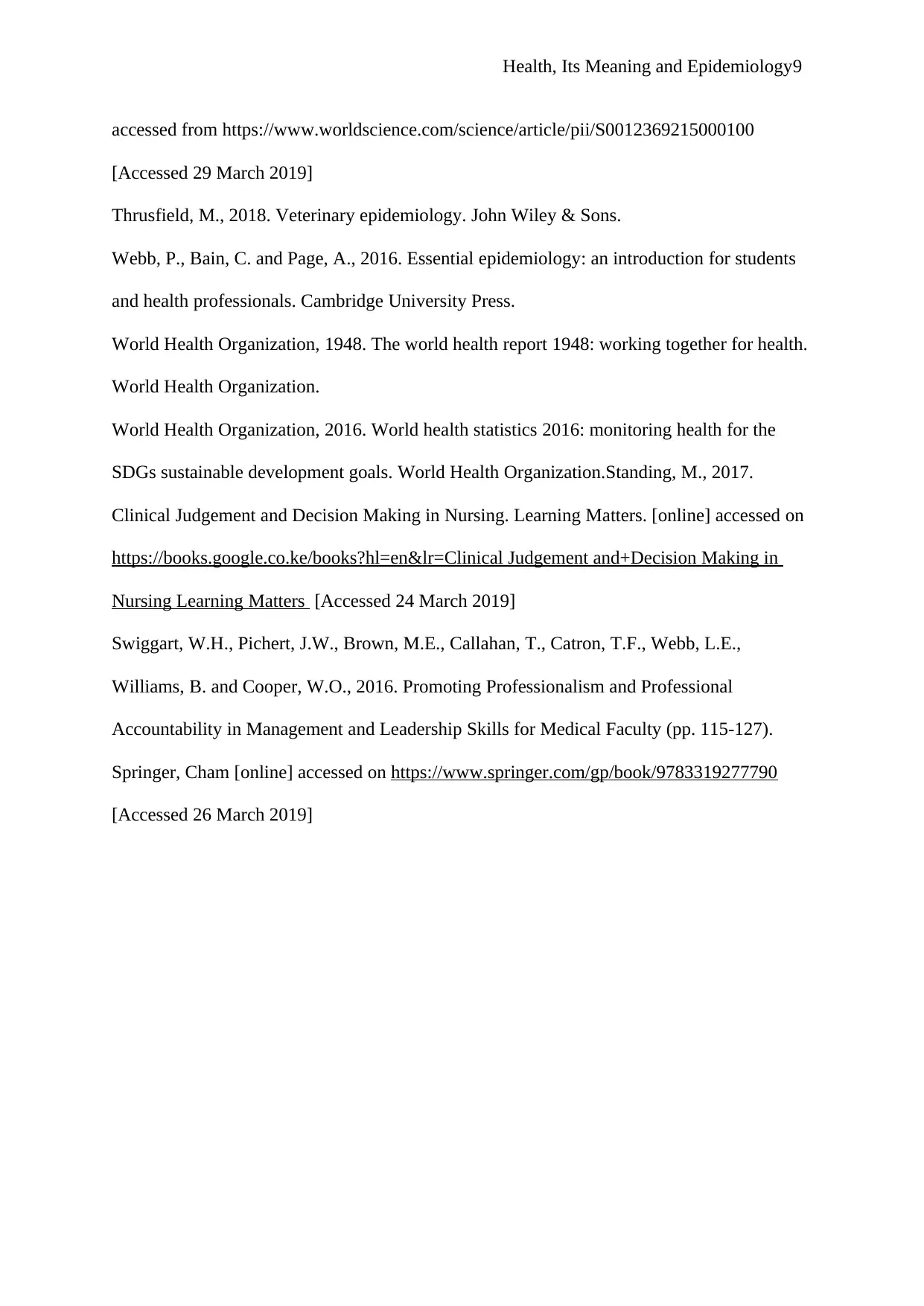
Health, Its Meaning and Epidemiology9
accessed from https://www.worldscience.com/science/article/pii/S0012369215000100
[Accessed 29 March 2019]
Thrusfield, M., 2018. Veterinary epidemiology. John Wiley & Sons.
Webb, P., Bain, C. and Page, A., 2016. Essential epidemiology: an introduction for students
and health professionals. Cambridge University Press.
World Health Organization, 1948. The world health report 1948: working together for health.
World Health Organization.
World Health Organization, 2016. World health statistics 2016: monitoring health for the
SDGs sustainable development goals. World Health Organization.Standing, M., 2017.
Clinical Judgement and Decision Making in Nursing. Learning Matters. [online] accessed on
https://books.google.co.ke/books?hl=en&lr=Clinical Judgement and+Decision Making in
Nursing Learning Matters [Accessed 24 March 2019]
Swiggart, W.H., Pichert, J.W., Brown, M.E., Callahan, T., Catron, T.F., Webb, L.E.,
Williams, B. and Cooper, W.O., 2016. Promoting Professionalism and Professional
Accountability in Management and Leadership Skills for Medical Faculty (pp. 115-127).
Springer, Cham [online] accessed on https://www.springer.com/gp/book/9783319277790
[Accessed 26 March 2019]
accessed from https://www.worldscience.com/science/article/pii/S0012369215000100
[Accessed 29 March 2019]
Thrusfield, M., 2018. Veterinary epidemiology. John Wiley & Sons.
Webb, P., Bain, C. and Page, A., 2016. Essential epidemiology: an introduction for students
and health professionals. Cambridge University Press.
World Health Organization, 1948. The world health report 1948: working together for health.
World Health Organization.
World Health Organization, 2016. World health statistics 2016: monitoring health for the
SDGs sustainable development goals. World Health Organization.Standing, M., 2017.
Clinical Judgement and Decision Making in Nursing. Learning Matters. [online] accessed on
https://books.google.co.ke/books?hl=en&lr=Clinical Judgement and+Decision Making in
Nursing Learning Matters [Accessed 24 March 2019]
Swiggart, W.H., Pichert, J.W., Brown, M.E., Callahan, T., Catron, T.F., Webb, L.E.,
Williams, B. and Cooper, W.O., 2016. Promoting Professionalism and Professional
Accountability in Management and Leadership Skills for Medical Faculty (pp. 115-127).
Springer, Cham [online] accessed on https://www.springer.com/gp/book/9783319277790
[Accessed 26 March 2019]
⊘ This is a preview!⊘
Do you want full access?
Subscribe today to unlock all pages.

Trusted by 1+ million students worldwide
1 out of 9
Related Documents
Your All-in-One AI-Powered Toolkit for Academic Success.
+13062052269
info@desklib.com
Available 24*7 on WhatsApp / Email
![[object Object]](/_next/static/media/star-bottom.7253800d.svg)
Unlock your academic potential
Copyright © 2020–2026 A2Z Services. All Rights Reserved. Developed and managed by ZUCOL.





